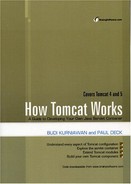Book Description
How Tomcat Works is the only book that explains the internal workings of Tomcat, the open source project used by millions of Java developers. Unlike other Tomcat titles, it is unique because it does not simply covers the configuration or servlet development with Tomcat. Rather, this book is meant for advanced readers interested in writing their own Tomcat modules or in understanding more beyond servlet/JSP programming.
The authors of this book have cracked open Tomcat 4 and 5 and revealed the internal workings of each component. Upon understanding the contents of this book, you will be able to develop your own Tomcat components or extend the existing ones.
In particular, this book explains:
- How to develop Java web servers
- Whether or not more Tomcat creates more than one instance for each servlet
- How Tomcat runs a servlet that implements the SingleThreadModel interface
- Why you cannot change the value of request parameters.
- The two main modules of a servlet container: connector and container
- How to build your own connector or extend the existing ones
- The four types of containers: engine, host, context, wrapper
- How Tomcat manages sessions and how to extend the session manager in a distributed environment.
- The class loader and how to create custom loaders
- How Tomcat implements security and basic/form-based/digest authentication
- How realms and login configuration work.
- How Tomcat processes the configuration file (server.xml) and converts the XML elements to Java objects using Digester
- Tomcat's shutdown hook
- JMX, Apache's Commons Modeler, and Tomcat JMX manageable resources
Table of Contents
- Copyright
- Introduction
- 1. A Simple Web Server
- 2. A Simple Servlet Container
- 3. Connector
- 4. Tomcat Default Connector
- 5. Container
- 6. Lifecycle
- 7. Logger
- 8. Loader
- 9. Session Management
- 10. Security
- 11. StandardWrapper
- 12. StandardContext
- 13. Host and Engine
- 14. Server and Service
- 15. Digester
- 16. Shutdown Hook
- 17. Tomcat Startup
- 18. Deployer
- 19. Manager Servlet
- 20. JMX-Based Management
